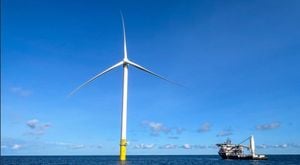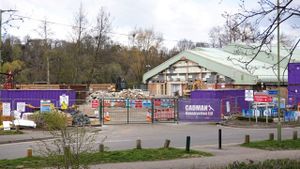Cubans have faced one of the most challenging periods of their recent history, grappling with the impacts of multiple natural disasters within just weeks of each other. The crises began with the destruction caused by Hurricane Oscar, which struck the eastern province of Guantánamo on October 21, 2024, followed by Hurricane Rafael on November 6, leading up to significant seismic activity, including a powerful earthquake on November 10. This series of events has resulted in widespread devastation, leading to loss of life, injury, and considerable damage to homes, infrastructure, and the already fragile power grid.
Hurricane Oscar, categorized as a tropical storm at the time, had already wreaked havoc before the region could fully recover. Reports indicated fatalities and missing persons as heavy rainfall flooded streets and landslide risks increased. The government declared an energy emergency just before Rafael's landfall, attributing it to existing issues with their aging infrastructure compounded by dwindling oil supplies.
Rafael intensified to Category 3 strength just before hitting the island, resulting in extensive damage across various provinces, particularly Artemisa and Pinar del Río. The storm knocked out power across large swathes of the country and forced evacuations. More than 283,000 individuals across Cuba were affected, and urgent relief efforts were undertaken by the Cuban government and various humanitarian organizations.
When the earthquake struck off the southern coast of Granma province, it registered at 6.8 on the Richter scale. This tremor followed closely on the heels of another, lesser quake measuring 5.9 earlier the same day. Although officials reported no immediate fatalities, seven people sustained injuries, including children, with widespread structural damage across over 2,000 homes and several educational and healthcare institutions.
The tremors were felt from Santiago de Cuba to as far away as southern Florida, prompting widespread panic and leading many residents to seek shelter from fears of subsequent aftershocks. An estimated 1,130 aftershocks followed the main quake, with over 47 of them being perceptible, adding to the anxiety already felt by locals still recovering from the impacts of the hurricanes.
Visual documentation shared via social media and news outlets showed homes reduced to rubble, with walls cracked and roofs collapsed throughout the region. Specifically, the towns of Pilón and Granma were heavily affected, with videos showing terrified residents evacuate to higher ground. The initial reports have prompted Cuban officials to act quickly, as power restoration and recovery efforts are complicated by the already crippled electrical grid.
On November 11, the National Defense Council convened to assess the situation, led by President Miguel Díaz-Canel. The council emphasized the need for coordinated responses to aid recovery efforts across the storm-ravaged and quake-hit areas. He highlighted the important roles played by local emergency services, doctors, and infrastructure workers who have mobilized to assist communities amid the cascading crises.
Despite these challenges, organizations such as Caritas Internationalis have stepped up to provide much-needed support. Their representatives are on the ground assessing damage and facilitating recovery, emphasizing the themes of solidarity and resilience. Jose Vicente Concepción, the director, noted, "We trust with collective effort, paths to recovery and hope will be opened." Such efforts reflect the broader community's commitment to rebuilding and restoring their lives.
The combination of hurricanes before the earthquake has illustrated Cuba's vulnerability to natural disasters, especially as its aging infrastructure struggles against the increasing frequency and severity of these calamities. This situation draws attention to the importance of strengthening disaster preparedness and fostering sustainable recovery strategies, particularly as climate change exacerbates the challenges communities face.
Currently, authorities are actively working to restore electricity and provide emergency services, but reports detail how many residents have been without access to basic necessities like food and clean water for extended periods. With many infrastructure challenges left unresolved from previous natural disasters, rebuilding efforts will require immense resources and coordination.
At the heart of these recovery efforts is the enduring spirit of the Cuban people who continue to display fortitude amid adversity. Neighbors are banding together to help one another, sharing what little resources they have, and advocating for each other as they face the aftermath of these disasters.
Reflecting on the current situation, many citizens are sharing personal stories of survival and heartbreak, highlighting the emotional toll these events have taken. Citizens like Maria Rodríguez, who lost her home to the storm, recounted, "One moment your life is normal, and the next, everything is gone. But we have each other, and we will rebuild together." This sense of community and resilience may serve as the foundation upon which Cuba can recover from these overwhelming challenges.
Experts suggest the likelihood of more seismic activity following last week's events, with authorities stressing the importance of preparedness and vigilance among residents. Earthquake drills are being reshuffled and discourse surrounding safety protocols is on the rise as Cuba navigates this difficult chapter. The National Institute of Seismology is monitoring trends, advising on precautions should future earthquakes strike.
Recovery from Hurricane Rafael and the earthquake will take considerable time and coordination. The Cuban government has been urged to expedite relief efforts and restore basic electrical and water services. With so many lives disrupted, frustrations have begun to surface, particularly around the speed and effectiveness of initial response efforts. Amid these grievances, Cuba's crisis is consistently framed within the broader issues of governance and infrastructure management challenging the island nation.
Following this series of disasters, humanitarian organizations are investing effort to receive and distribute aid to the most vulnerable populations, ensuring food assistance, water, and shelter are prioritized. Volunteers and aid teams from various nations and local agencies are mobilizing to help provide relief on the ground.
Looking forward, the simultaneous challenges of natural disasters and systemic deficiencies will test not just Cuba's infrastructure and governance, but the very fabric of community resilience. The experiences shared among Cubans and their collective will to adapt and survive may very well forge new pathways for recovery and transformation.
The immediate aftermath has sparked discussions about rebuilding strategies and disaster management protocols moving forward, focusing on sustainable practices and capacity development. How Cuba navigates through these trials, recovering from their recent traumas, may inform not just local but national responses to impending natural events.



